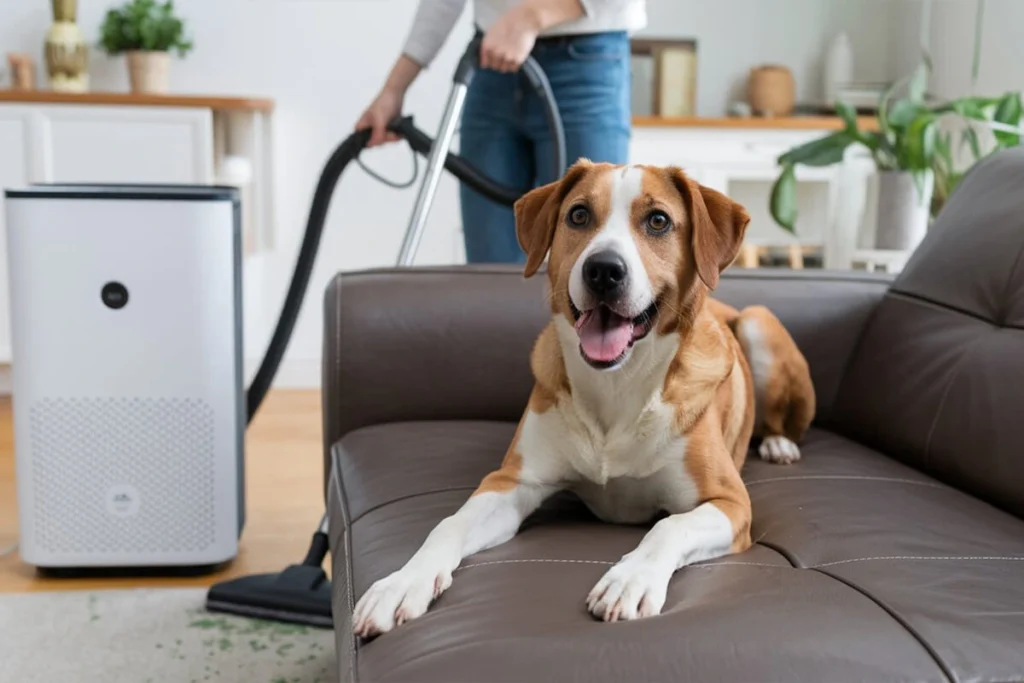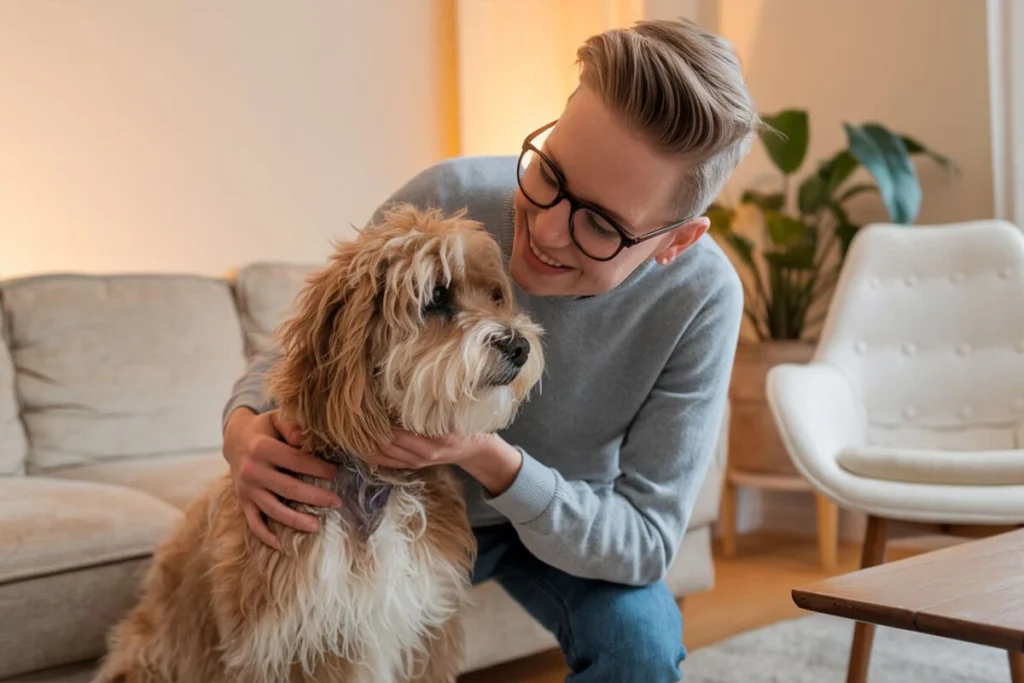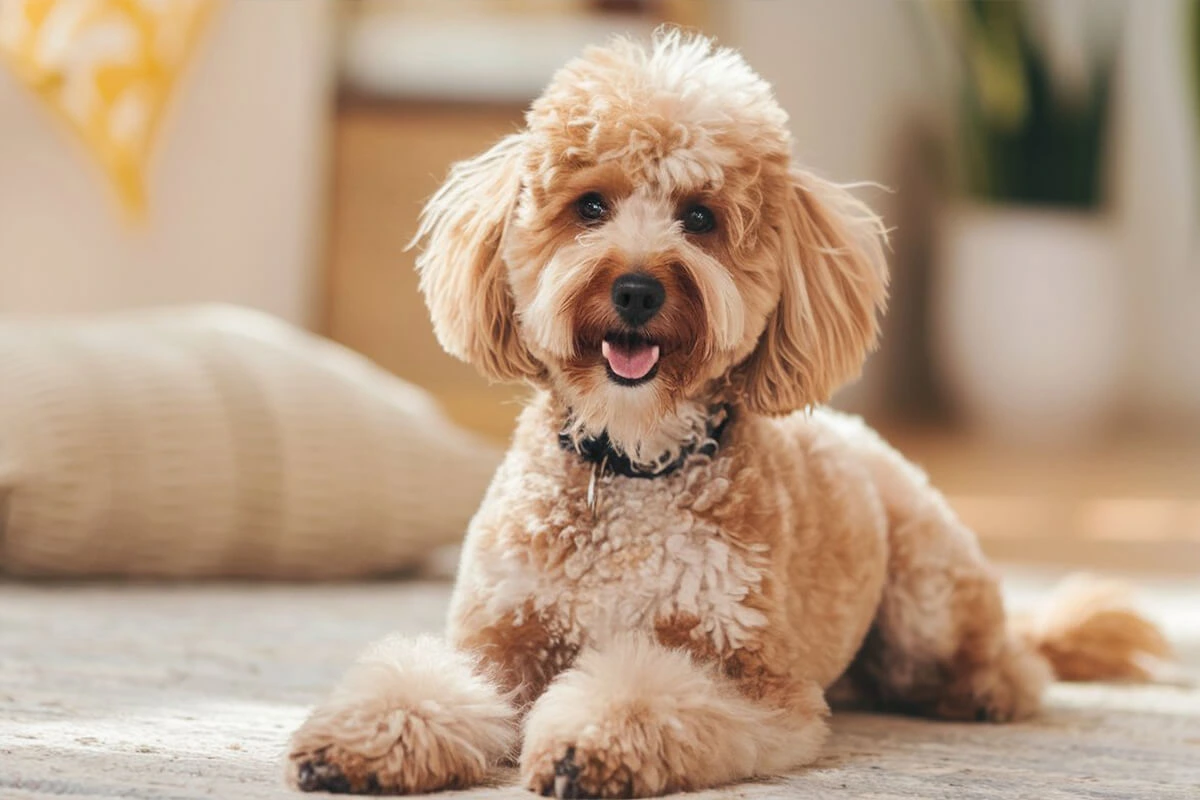Are you an allergy sufferer who loves dogs but struggles with sneezing, itchy eyes, or congestion around them? You’re not alone! Many people experience allergic reactions to pet dander, but that doesn’t mean you have to give up on having a furry friend. Hypoallergenic dogs offer a fantastic solution for those who want the companionship of a dog without constant allergy flare-ups. These breeds produce less dander and shed minimally, making them an excellent choice for an allergy-friendly home.
Understanding what makes a dog hypoallergenic can help you find the perfect breed that fits your lifestyle. While no dog is 100% allergy-free, certain breeds, such as Poodles, Maltese, and Schnauzers, have coats that trap dander and reduce allergen spread. Along with proper grooming and home maintenance, these dogs can significantly minimize allergic reactions.
In this guide, we’ll explore the best hypoallergenic dog breeds, what makes them suitable for allergy sufferers, and essential tips for creating a pet-friendly, allergy-free home. If you’ve been dreaming of having a dog but worry about allergies, this list will help you make an informed and comfortable choice. Let’s dive in!
What Makes a Dog Hypoallergenic?
Explanation of Dog Dander and Its Role in Allergies
Many people assume that dog hair causes allergies, but the real culprit is dog dander—tiny flakes of dead skin that dogs naturally shed. These microscopic particles contain proteins that trigger allergic reactions in sensitive individuals. When a dog sheds, dander spreads throughout the home, clinging to furniture, carpets, and clothing. This buildup can cause continuous allergy symptoms, including sneezing, coughing, itchy eyes, and congestion.
In addition to dander, dog saliva and urine also contain allergy-triggering proteins. When a dog licks its fur, these allergens transfer to the coat, dry up, and become airborne. Hypoallergenic dogs help reduce allergic reactions because they produce less dander or have coats that trap dander, preventing it from floating freely in the air. Understanding how dog dander works is the first step in choosing the right breed for an allergy-friendly home.
Importance of Low-Shedding in Hypoallergenic Dogs
If you struggle with pet allergies, choosing a low-shedding dog breed can make a huge difference. Shedding releases dander into the environment, increasing allergen exposure. Breeds that don’t shed excessively, such as Poodles, Maltese, and Portuguese Water Dogs, help keep dander levels under control. Their coats either grow continuously, trapping dander, or have unique textures that minimize shedding.
Unlike high-shedding breeds, which constantly release fur and allergens, hypoallergenic dogs require regular grooming to maintain their coats. While this means more brushing and trimming, it significantly reduces the spread of allergens. If you want a dog that won’t leave hair all over your home and trigger your allergies, focusing on non-shedding dog breeds is essential.
How Grooming and Care Impact Allergen Levels
Owning a hypoallergenic dog doesn’t guarantee an allergy-free experience, but proper grooming and care can further reduce allergen exposure. Regular baths help wash away dander and prevent allergen buildup on the coat. Using a mild, hypoallergenic shampoo designed for low-shedding dog breeds can keep the skin healthy and minimize flaking.
Brushing is another crucial step in controlling allergens. Brushing your dog’s coat several times a week removes loose fur and dander before it spreads around your home. A high-quality brush, especially one designed for curly or long-haired breeds like the Bichon Frise or Shih Tzu, helps keep the coat clean and tangle-free while trapping dander.
It is important to keep your home clean and tidy, just like grooming yourself is important. Investing in HEPA air purifiers, vacuuming regularly with a pet-friendly vacuum, and washing pet bedding frequently can help eliminate lingering allergens. By combining hypoallergenic dogs with a consistent grooming routine, you can enjoy the love and companionship of a dog without constant allergy symptoms.
7 Best Hypoallergenic Dogs
If you’re looking for a furry companion but suffer from allergies, choosing the right breed makes all the difference. Hypoallergenic dogs have coats that minimize shedding and help reduce the spread of allergens in your home. While no dog is completely allergy-free, these seven breeds produce less dander and are excellent choices for an allergy-friendly home.

1. Poodle – Intelligent, Low-Shedding, and Available in Different Sizes
Poodles rank among the best hypoallergenic dogs because of their curly, dense coat that traps dander and loose hair. They don’t shed much, which helps prevent allergens from spreading throughout the house. Available in Toy, Miniature, and Standard sizes, Poodles adapt easily to different living spaces, whether you live in an apartment or a large home.
Beyond their allergy-friendly coat, Poodles are highly intelligent and easy to train. They thrive on mental stimulation and physical activity, making them perfect for active individuals and families. However, their curly fur requires regular grooming to prevent matting and dander buildup. A consistent grooming routine keeps their coat in top condition while minimizing allergens.
2. Maltese – Small, Affectionate, and Has a Silky Coat That Doesn’t Shed Much
If you prefer a small, affectionate dog, the Maltese is an excellent choice. This breed has a long, silky coat that doesn’t shed heavily, making it one of the best small hypoallergenic dogs. Since their fur grows continuously, regular brushing helps prevent tangles and keeps dander under control.
Maltese dogs are known for their friendly and playful nature. They love being around their owners and thrive in indoor environments. Despite their elegant appearance, they are sturdy and adaptable, making them great companions for allergy sufferers who want a loving lap dog.
3. Bichon Frise – Playful and Has a Curly Coat That Traps Dander
The Bichon Frise is another fantastic hypoallergenic dog with a soft, curly coat that keeps dander from becoming airborne. These cheerful and affectionate dogs are known for their playful personalities and love for socializing. Their curly fur requires frequent brushing and professional grooming to stay clean and tangle-free, but this effort helps minimize allergens in your home.
Bichon Frises are small but energetic, making them a great fit for families, singles, or seniors. Their friendly nature and adaptability allow them to thrive in different living environments, whether in a spacious house or a cozy apartment.
4. Schnauzer – Comes in Different Sizes and Has a Wiry Coat That Minimizes Shedding
Schnauzers are a fantastic option for those seeking a low-shedding dog breed with a bold and energetic personality. Available in Miniature, Standard, and Giant sizes, they have a wiry double coat that reduces shedding and keeps allergens at bay. Regular hand-stripping or trimming helps maintain their coat and further reduces the spread of dander.
Known for their intelligence and protective nature, Schnauzers make excellent watchdogs and loyal companions. They require consistent training and daily exercise, making them ideal for active individuals or families looking for an energetic, allergy-friendly pet.
5. Labradoodle – A Crossbreed Known for Its Low-Shedding Qualities
The Labradoodle, a cross between a Poodle and a Labrador Retriever, has gained popularity as one of the best dogs for allergies. While not all Labradoodles are hypoallergenic, those with a curly or wavy Poodle-like coat tend to shed less and produce fewer allergens. Their coat texture varies, so it’s essential to choose one with a fleece or wool coat if you have allergies.
Labradoodles are highly social, intelligent, and affectionate. They thrive in active households and require regular exercise to stay happy. Their curly coats need consistent brushing and grooming to prevent matting and dander buildup, but with proper care, they can be a great hypoallergenic companion.
6. Shih Tzu – A Small Companion Dog with a Hair-Like Coat
The Shih Tzu is a small hypoallergenic dog with a long, flowing coat that resembles human hair rather than fur. Unlike other breeds that shed heavily, the Shih Tzu’s hair grows continuously, making them a good choice for allergy sufferers. Regular grooming helps keep their coat tangle-free and reduces dander accumulation.
Shih Tzus are affectionate, gentle, and love being close to their owners. They are very good pets for inside the house and can live happily in small spaces, like apartments. Despite their small size, they have a big personality and enjoy playing, cuddling, and socializing with their families.
7. Portuguese Water Dog – Energetic and Has a Dense, Curly Coat That Traps Dander
The Portuguese Water Dog is an active, medium-sized breed with a curly, waterproof coat that helps contain dander. Originally bred for working in water, these dogs have high energy levels and need plenty of exercise to stay happy. Their dense coat requires regular brushing and trimming, but their minimal shedding makes them a great option for allergy sufferers.
Portuguese Water Dogs are loyal, intelligent, and eager to please. They thrive in active households and enjoy outdoor adventures. If you have an active lifestyle and want a hypoallergenic dog that can keep up with you, this breed is an excellent choice.
By choosing a breed that sheds less and produces minimal dander, you can enjoy the companionship of a dog without constant allergy symptoms. Each of these hypoallergenic dogs has unique traits and care needs, so consider your lifestyle and preferences when selecting the perfect allergy-friendly pet.
How to Minimize Allergies in a Pet-Friendly Home
Even if you bring home one of the best hypoallergenic dogs, you still need to take extra steps to keep allergens under control. Dander, saliva, and hair can accumulate over time, triggering allergic reactions. By following proper grooming routines, investing in air purifiers, maintaining a clean home, and using hypoallergenic dog products, you can create an allergy-friendly home where both you and your pet can thrive.
Regular Grooming and Bathing for Hypoallergenic Dogs
Consistent grooming plays a crucial role in reducing pet allergens. Brushing your hypoallergenic dog at least three to four times a week helps remove loose hair and dander before it spreads around your home. Some low-shedding dog breeds, such as Poodles, Bichon Frises, and Portuguese Water Dogs, have curly or dense coats that trap allergens. Without regular grooming, dander can build up in their fur, increasing allergy risks.

Bathing your dog every two to four weeks further reduces dander and keeps their coat clean. Use a hypoallergenic dog shampoo designed to soothe sensitive skin and prevent excessive dryness, which can cause more dander production. Make sure to dry your dog thoroughly, especially if they have a thick or curly coat, to prevent irritation or matting.
For best results, schedule professional grooming every four to six weeks, especially for breeds that require trimming. A skilled groomer can help maintain your dog’s coat, remove excess hair, and minimize allergen spread. Keeping up with grooming not only helps with allergies but also keeps your dog healthy and comfortable.
Investing in HEPA Air Purifiers
Even with a low-shedding dog breed, some pet dander and allergens will still become airborne. A high-quality HEPA air purifier can help trap these microscopic particles and improve indoor air quality. HEPA filters capture up to 99.97% of allergens, including dander, dust, and pollen, creating a cleaner and healthier living space.
Place air purifiers in areas where your dog spends the most time, such as the living room and bedroom. If you allow your dog on the bed or couch, using an air purifier in those spaces can significantly reduce allergens in the air. Additionally, keeping windows open for fresh air circulation can help prevent dander buildup indoors.
Regularly changing the filters in your HEPA purifier ensures optimal performance. Some advanced models come with activated carbon filters that also help eliminate pet odors, creating a fresher and more comfortable home environment. Investing in air purification is one of the most effective ways to manage canine allergies and maintain an allergy-friendly home.
Cleaning Strategies to Reduce Pet Dander
Keeping your home clean is essential when living with a hypoallergenic dog. Even breeds that shed minimally still produce dander, which settles on floors, furniture, and fabrics. Following a consistent cleaning routine helps remove allergens before they accumulate and cause symptoms.
Effective Cleaning Tips for Allergy-Friendly Homes:
- Vacuum Frequently: Use a vacuum cleaner with a HEPA filter to trap pet dander and fine particles. Vacuum carpets, rugs, furniture, and pet beds at least twice a week.
- Wash Pet Bedding: Clean your dog’s bed, blankets, and toys regularly to prevent allergen buildup. Use a hypoallergenic detergent that’s free from harsh chemicals.
- Mop Hard Floors: Dander easily settles on hardwood, tile, and laminate floors. Mopping with a damp cloth or a pet-safe floor cleaner removes allergens more effectively than sweeping.
- Limit Fabric Surfaces: Dander clings to upholstery, curtains, and carpets. Opt for leather or vinyl furniture instead of fabric and use washable slipcovers when possible.
- Use Anti-Allergen Sprays: Spraying furniture and bedding with an allergen-reducing spray can help neutralize dander and keep allergens from becoming airborne.
By implementing these cleaning strategies, you can significantly reduce allergen levels and enjoy a healthier environment while living with a hypoallergenic dog.
Choosing Hypoallergenic Dog Products
Selecting the right hypoallergenic dog products can further minimize allergic reactions. Many pet care items, from shampoos to dog food, contain ingredients that may trigger allergies in both humans and dogs. Choosing products designed for allergy-sensitive pets ensures a safer and more comfortable living experience.
Essential Hypoallergenic Products for Dogs:
- Hypoallergenic Dog Shampoo: Look for formulas with natural ingredients like oatmeal, aloe vera, and coconut oil to soothe the skin and reduce dander. Stay away from shampoos that have strong smells, colors, or harsh chemicals.
- Allergy-Friendly Dog Beds: Hypoallergenic dog beds feature materials resistant to dust mites and allergens. Washable covers make maintenance easier and help keep dander under control.
- Grain-Free or Limited-Ingredient Dog Food: Some dogs develop skin allergies from common pet food ingredients, leading to excessive scratching and increased dander. Feeding a hypoallergenic dog high-quality food with limited ingredients can improve coat health and reduce shedding.
- Anti-Allergen Wipes: Pet-safe wipes help remove dander, dirt, and saliva between baths. Using wipes daily can keep allergens in check, especially if your dog frequently spends time on furniture.
- Hypoallergenic Grooming Tools: Brushes designed for low-shedding dog breeds, such as slicker brushes or de-shedding combs, help control fur and dander without irritating your dog’s skin.
Choosing the right products makes it easier to manage canine allergies and maintain an allergy-friendly home.
By combining regular grooming, air purification, thorough cleaning, and hypoallergenic dog products, you can significantly reduce allergen exposure and enjoy life with your furry companion without constant allergy symptoms. Creating a pet-friendly environment that supports both you and your hypoallergenic dog ensures a happier and healthier home.
Is a Hypoallergenic Dog Right for You?
Bringing home a hypoallergenic dog can be life-changing for allergy sufferers, but choosing the right breed requires careful consideration. While hypoallergenic dogs produce less dander and shed minimally, they still require grooming, care, and lifestyle adjustments to keep allergen levels low. Before making a decision, evaluate your allergy sensitivity, test your reaction to specific breeds, and assess whether your lifestyle aligns with the needs of a low-shedding dog breed.
Factors to Consider Before Getting a Hypoallergenic Dog
Owning a hypoallergenic dog doesn’t automatically mean you’ll have an allergy-free experience. Several factors determine whether a specific breed will be compatible with your needs.
1. Severity of Your Allergies
Assess how strongly you react to pet allergens before committing to a dog. Some people with mild allergies can comfortably live with allergy-friendly dogs, while others may still experience symptoms despite choosing a low-shedding dog breed. If your allergies are severe, consult an allergist before bringing a dog home. They can perform tests to determine how sensitive you are to pet dander and whether managing allergies with a dog is realistic.
2. Grooming and Maintenance Needs
Most hypoallergenic dogs require regular grooming to keep their coats clean and dander-free. If you choose a breed like a Poodle or Bichon Frise, expect to brush their fur several times a week and schedule professional grooming every four to six weeks. If you don’t have the time or budget for frequent grooming, consider a breed with lower maintenance needs, such as a Schnauzer.
3. Space and Living Environment
Think about your living situation before selecting a breed. Some small hypoallergenic dogs, such as the Maltese and Shih Tzu, adapt well to apartment living, while larger breeds like the Labradoodle and Portuguese Water Dog need more space and outdoor access. Regardless of size, keeping your home clean and ventilated plays a crucial role in managing allergens.
4. Activity Level and Temperament
Each hypoallergenic dog breed has a unique personality and energy level. Some breeds, like Poodles and Portuguese Water Dogs, need plenty of physical activity and mental stimulation. If you have a busy schedule or prefer a laid-back pet, a lower-energy breed like the Maltese or Shih Tzu may be a better fit. Choose a breed that matches your lifestyle to ensure a happy and long-lasting companionship.
Testing Your Allergies with Specific Breeds
Before committing to a hypoallergenic dog, spend time around different breeds to see how your body reacts. Even within the same breed, individual dogs may produce varying levels of allergens. Testing your response helps prevent surprises and ensures you choose a pet that won’t trigger severe allergy symptoms.

Ways to Test Your Allergies Before Adopting a Dog:
- Visit Breeders or Shelters: Spend time interacting with specific low-shedding dog breeds in a controlled environment. Petting and handling the dog will help determine if you react to their dander.
- Stay with a Dog Owner: If you have friends or family members with hypoallergenic dogs, spend a few hours in their home to see if you develop any symptoms.
- Schedule an Allergy Test: An allergist can perform a skin or blood test to measure your sensitivity to pet dander and saliva. This test can help confirm if you can tolerate certain breeds.
- Try Short-Term Fostering: Some rescues and shelters allow potential owners to foster dogs temporarily. Fostering provides real-life exposure to a specific breed and helps you determine if allergy symptoms are manageable.
Testing different breeds reduces the risk of choosing a pet that may cause constant allergy flare-ups. Finding a hypoallergenic dog that aligns with your health needs makes the adoption process smoother and more enjoyable.
Lifestyle Considerations for Hypoallergenic Dog Owners
Living with a hypoallergenic dog requires adjustments to ensure both you and your pet stay healthy and comfortable. Beyond grooming and cleaning routines, your daily habits and lifestyle choices impact how well you manage allergens in your home.
1. Establishing an Allergy-Friendly Home
Set up a pet-friendly environment that minimizes allergen buildup. Use HEPA air purifiers, wash pet bedding regularly, and create designated areas where your dog can rest without spreading dander throughout the home. Avoid letting your dog sleep on your bed if you have severe allergies.
2. Committing to a Grooming Schedule
Grooming plays a key role in controlling allergens, so establish a routine that works for you. If you don’t have time for frequent brushing, consider professional grooming services. Keeping your dog’s coat well-maintained ensures a healthier home environment.
3. Managing Outdoor Exposure
Some hypoallergenic dogs love outdoor activities, which means they may bring pollen and dust back inside. Wiping their paws and coat with pet-safe wipes before entering your home prevents additional allergens from spreading indoors.
4. Planning for Long-Term Care
Dogs require long-term care and attention, so consider how your lifestyle may change in the coming years. If you travel often, ensure you have a plan for pet care. If you have children or plan to start a family, choose a breed that interacts well with kids.
By evaluating these factors before adopting a hypoallergenic dog, you can make an informed decision and create an allergy-friendly home that suits both you and your future pet.
Conclusion
Choosing the right hypoallergenic dog can transform your home into a comfortable and allergy-friendly environment while allowing you to experience the joys of pet ownership. While no dog is completely free from allergens, low-shedding dog breeds produce less dander and hair, making them a great option for people with canine allergies. By selecting a breed that matches your lifestyle and taking proper precautions, you can successfully manage allergies and enjoy a strong bond with your pet.
Regular grooming and bathing play a critical role in reducing dander and keeping allergens under control. Investing in HEPA air purifiers, maintaining a consistent cleaning routine, and using hypoallergenic dog products further help minimize allergen buildup. Testing your allergies with specific breeds before making a commitment ensures that you choose a dog that won’t trigger severe symptoms.
Beyond allergy management, consider your living space, activity level, and long-term ability to care for a hypoallergenic dog. Some breeds, like the Poodle and Labradoodle, require frequent exercise and grooming, while smaller breeds like the Maltese and Shih Tzu may better suit apartment living. Understanding the needs of your chosen breed will create a healthier and happier home for both you and your pet.
With the right precautions, you can enjoy life with a hypoallergenic dog while keeping allergies under control. By making informed choices and staying committed to proper care, you can experience the companionship and unconditional love that dogs bring without constantly struggling with allergy symptoms.
Find Out More About Hypoallergenic Cats Here.
To Discover more about Dogs and breeds, you can Check This!
Find Some Good Stuff For your Dog On Ped MD Official Website.
